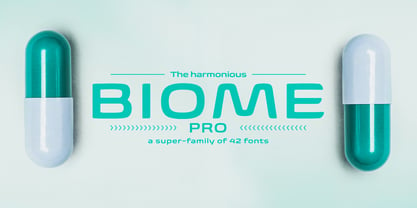Wählen Sie diesen Lizenztyp, wenn Sie eine app für iOS, Android oder Windows Phone entwickeln und Sie die Datei Font in den Code Ihrer mobilen Anwendung einbetten.
Biome™
von Monotype
- Aa Glyphen
-
Bestes AngebotFamilienpakete
- Einzelschnitte
- Technische Daten
- Lizenzierung
Über die Schriftfamilie Biome
In den Skizzen, die die Grundlage für seine Schrift Biome bildeten, experimentierte Crossgrove mit Innen- und Außenformen in verschiedenen Stilen, passte Buchstaben an die Form der Superellipse an und hinzugefügt am Kurven, um sie dann wieder zu entfernen. Seine Herausforderung bestand darin, einen harmonischen und kohärenten Ansatz zu finden, der einen ausreichenden Kontrast zu den bestehenden Fonts bietet. Biome steht im Wesentlichen in der Tradition der serifenlosen Schriften, und die Buchstaben weisen nur geringfügige Unterschiede in der Strichstärke auf. An vielen Stellen wird die Super-Ellipse angedeutet, aber sie wird nie zum vorherrschenden Gestaltungsfaktor. Während die meisten Enden der vertikalen Striche nur leicht gerundet sind, weisen die horizontalen und diagonalen Striche ausgeprägte Bögen auf, die im Wesentlichen den runden und weichen Charakter der Schrift bestimmen. Die eher unkonventionell geformten Buchstaben, wie der Kleinbuchstabe "g" mit seinen beiden halboffenen Zählern und die "k" und "x" mit ihren Querbalken, verleihen der Biome eine individuelle Persönlichkeit. Dieser Effekt wird durch die großzügig abgerundeten Glieder des "v" und "w" sowie der Großbuchstaben "M" und "N" noch verstärkt. Biome wurde als Superfamilie von Schriften konzipiert. Von der fast haarfeinen Extra Light bis zur großzügig proportionierten Ultra gibt es sieben klar differenzierte Strichstärken und drei Laufweiten. Von allen Varianten gibt es schräge Kursivversionen. Das Sortiment umfasst Kapitälchen und Ziffernsätze mit Klein- und Großbuchstaben. Mit der Biome lassen sich Texte in allen osteuropäischen Sprachen setzen. Obwohl die bemerkenswerte Individualität der Biome am deutlichsten in den größeren Punktgrößen zum Ausdruck kommt, eignet sich diese Schrift nicht nur für die Erstellung von Überschriften und Logos. Dank ihrer eleganten visuellen Wirkung fühlt sich die Biome auch in kurzen Texten wohl, während ihre große x-Höhe und die großzügigen Zählwerke sie auch in den kleinen Größen von Font gut lesbar machen. Biome ist eine zeitgenössische Schrift mit futuristischen Elementen aus der Mitte des 20. Jahrhunderts, die ihr ironischerweise einen Retro-Charakter verleihen.
Designer: Carl Crossgrove
Herausgeber: Monotype
Foundry: Monotype
Eigentümer des Designs: Monotype
MyFonts Debüt: null

Über Monotype
Die Monotype Library ist eine der weltweit größten und umfangreichsten Schriftensammlungen, die sowohl historisch bedeutsame Originaldesigns als auch ein frisches Angebot an zeitgenössischen und modischen Fonts enthält. Die Monotype Library umfasst Tausende von zeitlosen Klassikern, handgefertigten Wiederbelebungen und Originaldesigns von vielen der innovativsten Schriften Designer und Foundrys der Geschichte. Diese unverwechselbare, preisgekrönte Bibliothek von Premium Fonts bietet Marken und Designer eine breite und zuverlässige Auswahl an Schriften für ausdrucksstarke Typografie im Druck und auf dem Bildschirm. Die Seite Premium Foundry kann hier eingesehen werden.
Mehr lesen
Weniger lesen